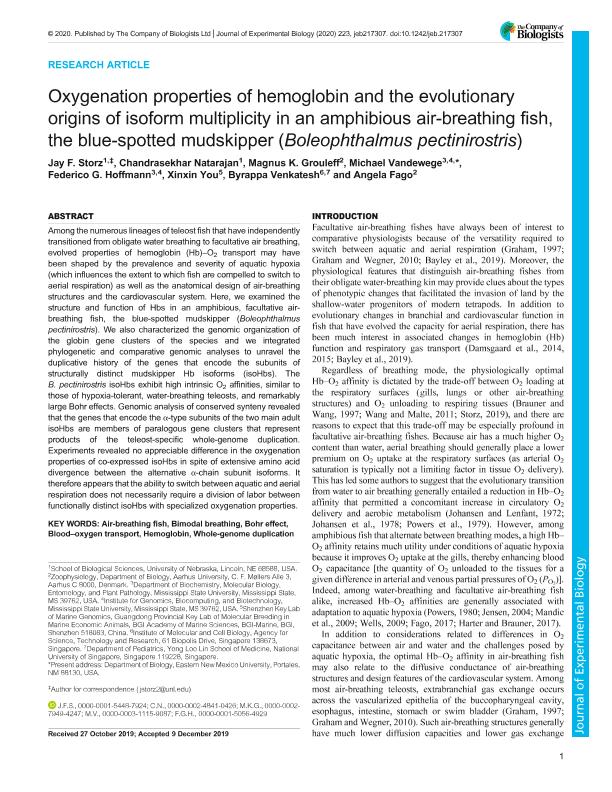Artículo
Structure and function of crocodilian hemoglobins and allosteric regulation by chloride, ATP, and CO2
Fago, Angela; Natarajan, Chandrasekhar; Pettinati, Martín ; Hoffmann, Federico G.; Wang, Tobias; Weber, Roy E.; Drusin, Salvador Iván
; Hoffmann, Federico G.; Wang, Tobias; Weber, Roy E.; Drusin, Salvador Iván ; Issoglio, Federico Matías
; Issoglio, Federico Matías ; Marti, Marcelo Adrian
; Marti, Marcelo Adrian ; Estrin, Dario Ariel
; Estrin, Dario Ariel ; Storz, Jay F.
; Storz, Jay F.
 ; Hoffmann, Federico G.; Wang, Tobias; Weber, Roy E.; Drusin, Salvador Iván
; Hoffmann, Federico G.; Wang, Tobias; Weber, Roy E.; Drusin, Salvador Iván ; Issoglio, Federico Matías
; Issoglio, Federico Matías ; Marti, Marcelo Adrian
; Marti, Marcelo Adrian ; Estrin, Dario Ariel
; Estrin, Dario Ariel ; Storz, Jay F.
; Storz, Jay F.
Fecha de publicación:
03/2020
Editorial:
American Physiological Society
Revista:
American Journal of Physiology: Regulatory, Integrative and Comparative Physiology
ISSN:
0363-6119
Idioma:
Inglés
Tipo de recurso:
Artículo publicado
Clasificación temática:
Resumen
Hemoglobins (Hbs) of crocodilians are reportedly characterized by unique mechanisms of allosteric regulatory control, but there are conflicting reports regarding the importance of different effectors, such as chloride ions, organic phosphates, and CO2. Progress in understanding the unusual properties of crocodilian Hbs has also been hindered by a dearth of structural information. Here, we present the first comparative analysis of blood properties and Hb structure and function in a phylogenetically diverse set of crocodilian species. We examine mechanisms of allosteric regulation in the Hbs of 13 crocodilian species belonging to the families Crocodylidae and Alligatoridae. We also report new amino acid sequences for the α- and β-globins of these taxa, which, in combination with structural analyses, provide insights into molecular mechanisms of allosteric regulation. All crocodilian Hbs exhibited a remarkably strong sensitivity to CO2, which would permit effective O2 unloading to tissues in response to an increase in metabolism during intense activity and diving. Although the Hbs of all crocodilians exhibit similar intrinsic O2-affinities, there is considerable variation in sensitivity to Cl- ions and ATP, which appears to be at least partly attributable to variation in the extent of NH2-terminal acetylation. Whereas chloride appears to be a potent allosteric effector of all crocodile Hbs, ATP has a strong, chloride-independent effect on Hb-O2 affinity only in caimans. Modeling suggests that allosteric ATP binding has a somewhat different structural basis in crocodilian and mammalian Hbs.
Palabras clave:
ADAPTATION
,
ALLOSTERY
,
BLOOD
,
OXYGEN TRANSPORT
,
REPTILE
Archivos asociados
Licencia
Identificadores
Colecciones
Articulos(INQUIMAE)
Articulos de INST.D/QUIM FIS D/L MATERIALES MEDIOAMB Y ENERGIA
Articulos de INST.D/QUIM FIS D/L MATERIALES MEDIOAMB Y ENERGIA
Articulos(IQUIBICEN)
Articulos de INSTITUTO DE QUIMICA BIOLOGICA DE LA FACULTAD DE CS. EXACTAS Y NATURALES
Articulos de INSTITUTO DE QUIMICA BIOLOGICA DE LA FACULTAD DE CS. EXACTAS Y NATURALES
Citación
Fago, Angela; Natarajan, Chandrasekhar; Pettinati, Martín; Hoffmann, Federico G.; Wang, Tobias; et al.; Structure and function of crocodilian hemoglobins and allosteric regulation by chloride, ATP, and CO2; American Physiological Society; American Journal of Physiology: Regulatory, Integrative and Comparative Physiology; 318; 3; 3-2020; R657-R667
Compartir
Altmétricas



